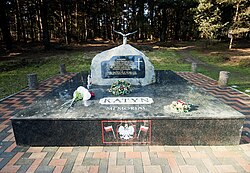Cannock Chase
Cannock Chase is a woodland and mixed area of countryside in the county of Staffordshire, England. The area has been designated as the Cannock Chase Area of Outstanding Natural Beauty. The Chase gives its name to the local government district.
| Cannock Chase | |
|---|---|
 Cannock Chase AONB | |
| Location | Staffordshire, England |
Economy
Cannock Chase is between Cannock, Lichfield, Rugeley and Stafford. It is a mixture of natural deciduous woodland, coniferous plantations, open heathland and the remains of early industry, such as coal mining.
Nature
Cannock Chase was made an Area of Outstanding Natural Beauty (AONB) on 16 September 1958. Much of the area is also a Site of Special Scientific Interest (SSSI). Despite its relatively small area, the chase has a remarkable variety of landscape and wildlife.
The wildlife includes a herd of about 800 fallow deer. There are a number of rare and endangered birds, like the migrant Nightjars. A feeding station attracts many species, including Brambling, Yellowhammer and Bullfinch.
Efforts are underway to increase the amount of heathland on the chase, reintroducing shrubs such as heather in some areas where bracken and birch forest have crowded out most other plants. The local flora also includes several species of Vaccinium, including the Cannock Chase Berry (Vaccinium ×intermedium Ruthe).[1]
On the Chase's north-eastern edge can be found Shugborough Hall, ancestral home of the Earls of Lichfield. At its southern edge are the remains of Castle Ring, an Iron Age hill fort, which is the highest point on the Chase. Several glacial erratic boulders are also found on the Chase, remnants of glaciation. One is mounted on a plinth.
Since 2006, the forest has been used as an open-air music venue as part of the Forestry Commission nationwide Forest Tour, with acts such as The Zutons, The Feeling, Status Quo and Jools Holland playing in a forest clearing.
Media attention
The area gained notoriety in the late 1960s when the Cannock Chase murders made national headlines; the remains of three young girls were found buried on the Chase after going missing from areas along the A34 road between there and Birmingham. Raymond Leslie Morris, a motor engineer from Walsall, was found guilty at Stafford assizes of one of the murders in 1968 and was sentenced to life imprisonment. He is still in prison over 40 years later and one of the country's longest serving prisoners.[2][3]
Geology
The landscape owes much to the underlying Triassic "bunter" formations. These are sandstone deposits containing rounded pebbles. They can be found in Warwickshire, Cheshire, Staffordshire, Nottinghamshire, Yorkshire, Devon and Dorset in England. They are thought to be alluvial deposits.[4] Judging from the rounding of the mainly quartzite pebbles, they were carried for a long time in a large and turbulent river. The hard pebbles got powerful abrasion. The deposits in the English Midlands are thought to have been carried northwards from Brittany in northern France.
References
- ↑ "The Flora of Cannock Chase". Cannockchasehistory.org.uk. Archived from the original on 2011-09-11. Retrieved 2011-02-25.
- ↑ James Cartledge (2005-09-08). "James Cartledge, ''Child killer should rot in prison,'' Birmingham Evening Mail, 8 September 2005". Birminghammail.net. Archived from the original on 2008-12-02. Retrieved 2011-02-25.
- ↑ "Raymond Morris, updated August 2001". Murder UK. Retrieved 2011-02-25.
- ↑ Alluvium: water-washed loose deposits, not consolidated (not cemented). Usually recent deposits laid down by a river.
